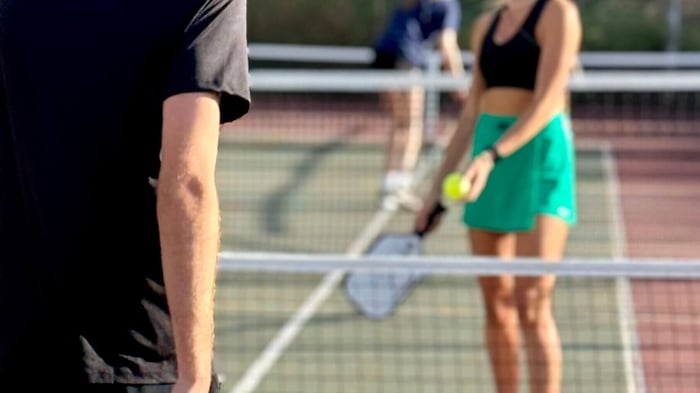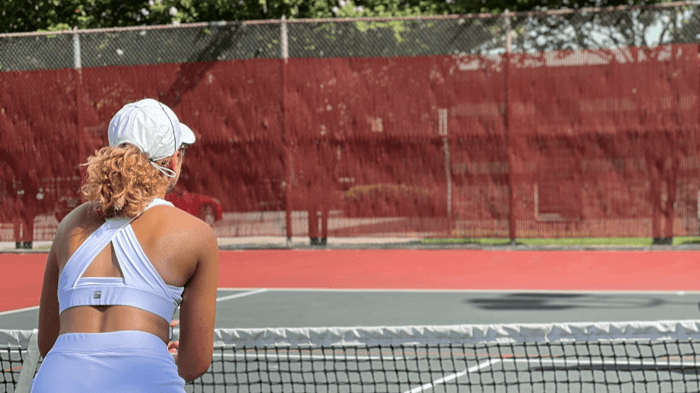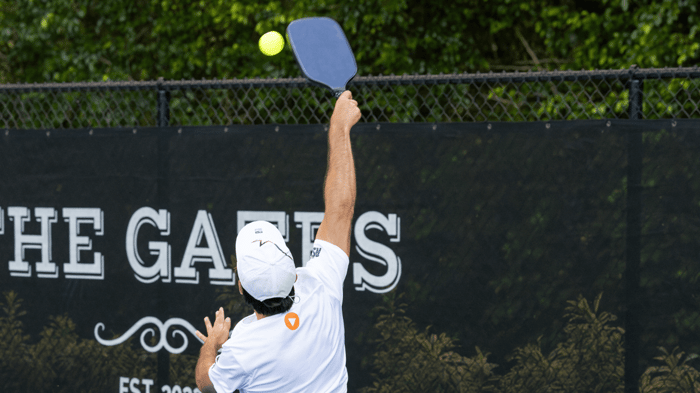Key takeaways:
Converting a tennis court to pickleball is cost-effective, relatively simple, and enhances community engagement.
Proper planning and high-quality materials are crucial for creating a safe, regulation-compliant pickleball space.
With the right equipment and thoughtful execution, your new court can become a vibrant hub for recreation and social connection.
Imagine transforming a single tennis court into a lively hub where four pickleball games can unfold simultaneously. As pickleball captivates more players across communities, the need for accessible courts has never been greater. Converting a tennis court to a pickleball court offers a brilliant solution, fostering increased court usage and bringing people together through this engaging sport.
The conversion process is remarkably straightforward and cost-effective. With a simple adjustment of lowering the net by 2 inches to 34 inches at the center and adding new court lines, you can create up to four pickleball courts on one tennis court. This efficient use of space meets the rising interest in pickleball and revitalizes underutilized tennis facilities.
At PB5star, we're passionate about nurturing the pickleball community and enhancing your playing experience. We invite you to explore our collection of premium, performance-driven pickleball gear on our website, designed to elevate your game and style on any court.
Why convert a tennis court?
Transforming tennis courts into pickleball havens brings a wealth of advantages to communities and sports facilities. Its charm lies in its simplicity and quick learning curve, making it a hit with players of all ages and abilities. Pickleball's growing popularity presents a unique opportunity to revitalize underutilized tennis courts and create vibrant community spaces.
Increased participation and community engagement: Pickleball's easy learning curve and welcoming atmosphere attract a diverse range of players. Converting tennis courts to pickleball encourages greater participation and fosters a sense of community.
Enhanced social connections: The sport's social nature promotes interaction and camaraderie among players. Pickleball courts become gathering places where friendships blossom and a sense of belonging thrives.
Maximized court utilization: Pickleball's smaller court size allows multiple games to be played simultaneously on a single tennis court. This efficient use of space increases court availability and accommodates more players.
Boosted physical and mental well-being: Regular pickleball play provides numerous health benefits, including improved cardiovascular fitness, agility, and coordination. The sport's social aspect also contributes to mental well-being by reducing stress and promoting social interaction.
Whether you're a parks department rep, a private club manager, or a homeowner looking to refresh your backyard, a tennis court conversion to pickleball is a winning move. It unites people through sport, wellness, and shared joy.
Cost considerations
Before learning how to convert tennis courts to pickleball, it's important to understand the financial aspects involved. Whether planning a temporary setup or a long-term investment, knowing what to expect in terms of costs helps you make smart, budget-conscious decisions that align with your facility’s goals and community needs.
Increased revenue for sports facilities: The rising demand for pickleball creates new revenue streams for sports facilities and community centers. Offering court rentals, lessons, and tournaments can generate additional income.
Enhanced property values: Pickleball courts can increase property values and attract new residents to communities. Homeowners' associations recognize the appeal of pickleball amenities and their positive impact on resident satisfaction.
Vibrant community atmosphere: Pickleball courts contribute to a lively and active community atmosphere. The sport's popularity fosters a sense of shared purpose and creates opportunities for social interaction and engagement.
Estimated costs: Conversion costs range from minimal (for temporary tape and portable nets) to $3000+, depending on surface materials, paint, and permanent nets.
The transformation of tennis courts into pickleball havens represents a win-win scenario for communities and sports facilities. By embracing this trend, we can create inclusive spaces that promote physical activity, social connection, and community well-being.
Essential equipment for pickleball court conversions
Having the right tools not only ensures accurate measurements and layout but also extends the lifespan and playability of your court. Let's explore the key tools and materials you'll need for tennis court to pickleball conversion:
Measure with precision: Grab a professional-grade measuring tape to mark out the 20 feet wide by 44 feet long pickleball court dimensions
Create lasting lines: Choose premium, weather-resistant tape for crisp, durable court markings that enhance gameplay
Set up regulation nets: Select adjustable pickleball nets that can be positioned at the standard 34-inch center height
Choose your surface: Explore surfacing options ranging from $3,000 to $10,000, offering varied levels of durability and performance to suit your needs and budget
Investing in the right equipment sets your court up for long-term success and ensures an enjoyable experience for all players. Thoughtful preparation pays off every time someone steps onto the court to play.
Step-by-step conversion process
Converting a tennis court into a pickleball court is an excellent way to maximize space and cater to the growing popularity of this exciting sport. Clear, accurate lines are essential for fair play and smooth rallies. Here's how to convert a tennis court to pickleball.
Measure and mark the baseline and sidelines:
Start by measuring and marking the baseline (20 feet wide) and sidelines (44 feet long) of the pickleball court.
To ensure perfect alignment, begin your measurements from the center of the tennis court net.
Use a chalk line or straight edge to create crisp, straight lines.
Add the non-volley zone (kitchen) lines:
Measure 7 feet from each side of the net and mark these lines parallel to the net across the court's width.
The "kitchen" is a crucial area in pickleball where volleys are prohibited.
Mark the centerline and service courts:
Draw a line from the middle of each baseline to the kitchen line, dividing the court into four equal service courts.
Apply durable markings:
Choose a color that contrasts well with the existing tennis court lines to avoid confusion.
If using tape, thoroughly clean the surface before application to ensure proper adhesion.
If using paint, opt for court-specific paint designed for outdoor durability. Apply the paint carefully using a roller or brush.
Additional tips:
Double-check measurements: Accuracy is key! Take time with each step and ensure precise measurements before applying permanent markings.
Consider temporary markings: If you're unsure about the placement or want to test out the court, use temporary marking materials like masking tape or chalk before committing to permanent lines.
Maintenance: Regularly inspect the lines and touch them up as needed to maintain clear and visible markings.
With a little effort and attention to detail, you can convert an underutilized tennis court into a vibrant pickleball hub that brings your community together for fun, fitness, and friendly competition. So grab your measuring tape, gather some friends, and turn your tennis court into a pickleball paradise that will be the talk of the neighborhood!
As you prepare your court, imagine the laughter, cheers, and friendly competition soon filling the air. At PB5star, we believe in the power of pickleball to bring people together. That's why we've designed our performance-driven apparel to keep you comfortable and confident during every rally and between-game chat.
Safety & regulations
Before stepping onto the court to enjoy a game of pickleball, it's essential to ensure that the playing area meets safety and regulatory standards. These small but vital considerations help prevent injuries, protect the integrity of your playing surface, and promote a positive experience for everyone involved.
Think about the sun's positioning: Ideally, orient it north-south to minimize glare during play.
Ensure surface safety: Check for cracks, uneven patches, or debris that might interfere with play or line application.
Use court-approved paint and tape: For long-lasting and regulation-compliant markings.
Mind multi-use functionality: If you want the court to remain suitable for tennis, opt for removable nets and contrasting line colors.
Taking the time to follow these safety and regulation guidelines ensures your court is functional but also enjoyable and safe for all players. These thoughtful decisions reflect a commitment to community well-being and support the long-term success of your pickleball space.
Smooth out your court conversion: Pitfalls to avoid
Creating your pickleball paradise is an exciting journey, and we at PB5star want to help you make it a resounding success. Let's explore potential hurdles and how to gracefully clear them, ensuring your court conversion is as smooth as your backhand.
Rushing through measurements
Take a deep breath and resist the urge to speed through this crucial step. A regulation pickleball court is 20 feet wide by 44 feet long, and precision matters. Grab a friend and a reliable measuring tape, and take your time to get it right. Pro tip: Mark your measurements with temporary chalk first, then step back and visualize the gameplay before making anything permanent.
Skimping on materials
We know budget considerations are real, but quality is key when it comes to court markings. Invest in durable, weather-resistant tape or paint designed for sports courts to make the most of your tennis court conversion. These materials will keep your lines crisp and visible, match after match.
Neglecting player comfort
Think about the sun's position when laying out your court. Ideally, orient it north-south to minimize glare during play. This small detail can make a big difference in player comfort and safety, especially during those golden hour games. Your fellow players will thank you for this thoughtful touch!
Overlooking surface preparation
Before you start marking, give your court surface some attention. A thorough cleaning removes dirt and debris that could interfere with adhesion. For tape application, ensure the surface is clean and dry. If you're painting, repair any cracks or imperfections first. A smooth, well-prepared surface looks better and enhances gameplay, and we at PB5star are all about improving your pickleball experience.
Forgetting about versatility
If you want to convert tennis courts to pickleball courts, don't miss the opportunity to create a multi-use space. By lowering the tennis net to 34 inches in the center and adding taped pickleball lines, you can cater to tennis and pickleball enthusiasts. This approach maximizes pickleball tennis court conversions and usage and broadens your community of players, a win-win situation that aligns perfectly with PB5star's community-focused values.
Remember, the care you put into your court conversion will pay off in countless memorable games and new friendships. So take your time, do it right, and prepare to serve some serious fun on your new pickleball paradise!
Frequently asked questions (FAQ) about tennis to pickleball court conversion
Converting a tennis court into a pickleball court is an exciting opportunity to bring new energy to your space. Below, you'll find clear answers to the most common concerns, covering everything from costs and timelines to surface options and dual-use setups, to help you get started with confidence.
How long does it take to convert a tennis court to pickleball?
A basic conversion using temporary tape and portable nets can be completed in a few hours. Depending on weather and paint drying time, permanent setups involving resurfacing or professional services may take several days to a week.
Can a tennis court be used for both tennis and pickleball?
Yes! You can create a multi-use court by leaving the existing tennis net in place, lowering it slightly, and adding marked pickleball lines with tape or paint in a contrasting color. This setup allows for flexibility, supporting both sports without compromising gameplay quality.
What kind of surface is best for a pickleball court?
Pickleball can be played on asphalt, concrete, or acrylic-coated courts. Use a court-specific surfacing material that provides traction, reduces glare, and withstands weather for best results. If your budget allows, consider an acrylic overlay for improved playability and durability.
What are the costs involved in a tennis court conversion?
Conversion costs can range from as little as $200 (for DIY temporary tape and nets) to $10,000 or more for full resurfacing and permanent nets. Most community or personal projects fall between $500–$2,000, depending on the materials and labor involved.
Give your tennis court a makeover and improve your game
Transform your local tennis court into a bustling pickleball hub where players of all ages gather for friendly matches and lively conversation. This simple tennis court conversion process not only breathes new life into existing spaces but also creates a focal point for community connection and healthy competition. By adjusting net heights and adding strategic lines, you're crafting an inviting arena for social interaction, physical activity, and pure enjoyment.
While the transition to pickleball might seem straightforward, it's natural to encounter a few bumps along the way. From ensuring precise measurements to selecting durable materials, each step presents an opportunity to enhance the playing experience. At PB5star, we understand these nuances and how they contribute to your game. That's why we've designed our apparel to complement your on-court efforts, providing comfort and confidence as you navigate the learning curve or perfect your dink shot.
Want to dive into the world of pickleball? Start by reaching out to your local parks department or community center about court conversion possibilities. Then, gather a group of friends, grab some paddles, and experience firsthand why pickleball has captured the hearts of players nationwide. And when you're ready to take your game to the next level, explore our collection of premium gear because every great pickleball story deserves the perfect outfit to match.







